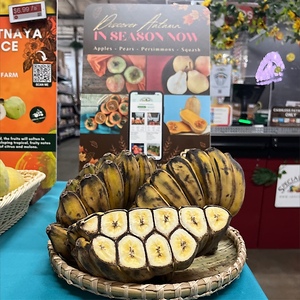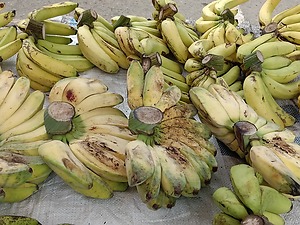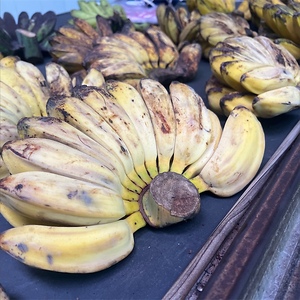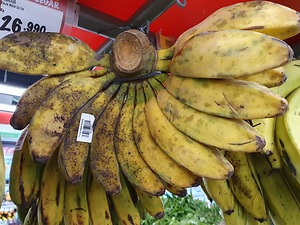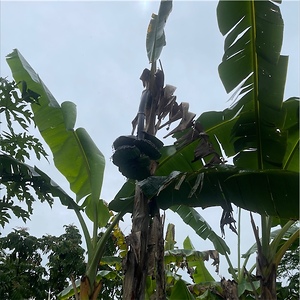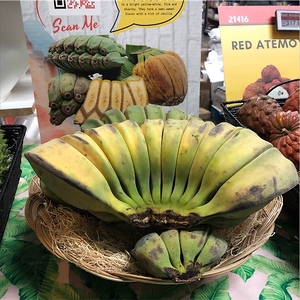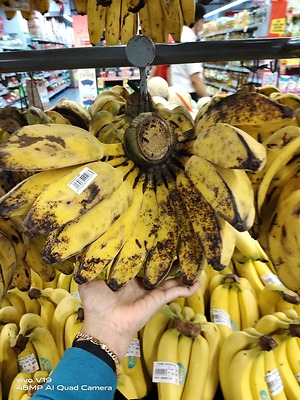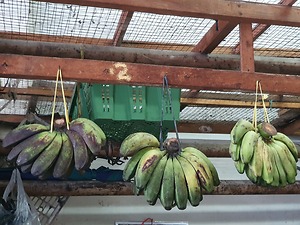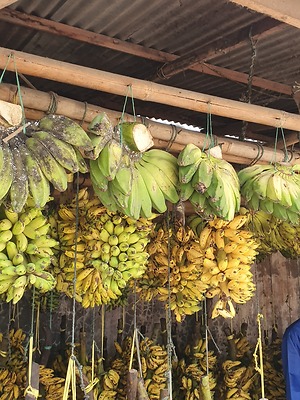

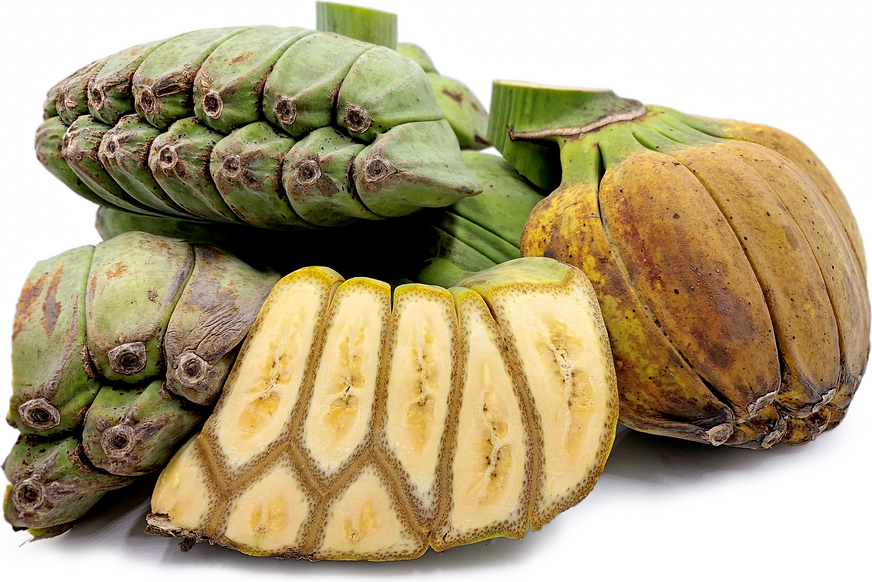
Praying Hands Bananas
Estimated Inventory, lb : 0
Description/Taste
Praying Hands bananas grow in medium to large hands on the end of a drooping flowering stalk. The hands vary in size, comprised of 6 to 20 fruits, and have an unusual compact shape of two rows of bananas fused together. Each banana has one flat side with a slight curve where it was pressing against the other half of the hand. The fruits also have an angular, short, and thick nature. The peel ripens from a dusty, muted green to bright yellow and may develop brown markings and tones. The peel is also easy to remove and has a brittle, leathery consistency. Beneath the peel, the yellow-white flesh is semi-firm, dense, juicy, and slightly starchy, softening and developing a creamy texture with age. Ripe Praying Hands bananas are said to have a softer exterior with a chewy core. The core also encases a few undeveloped black seeds that often go unnoticed, and the flesh browns slower than commercial banana varieties. Praying Hands bananas are consumed raw when they are ripe. The degree of ripeness is determined by feel and not necessarily color. The fruits should feel soft to the touch and be mostly yellow, if not partially brown and wrinkled. Once ripe, Praying Hands bananas can be individually removed without tearing the peel of the other fruits. Praying Hands bananas have a semi-sweet, tropical, custard-like taste with subtle lemon, vanilla, and grassy nuances.
Seasons/Availability
Praying Hands bananas are available year-round.
Current Facts
Praying Hands bananas, botanically classified as Musa acuminata x balbisiana, are a triploid hybrid ABB variety belonging to the Musaceae family. The short, thick, and angular bananas grow in dense, fused hands and are a part of the Saba subgroup. Praying Hands bananas earned their unusual name from their similarity in appearance of two hands being pressed together, similar to the posture taken when some people enter into prayer. The variety is thought to be native to Southeast Asia, where it has been utilized as a food source since ancient times. Multiple hands grow close together on fruiting stalks, also called racemes, jutting out sideways or slightly hanging toward the ground, and the bananas typically ripen over a 2 to 3 month period after appearing on the stalk. Praying Hands bananas are also known as Ripping, Inabaniko, Binendito, Oremos, and Domino in the Philippines and Uht Kapakap in Micronesia. The variety is not commercially produced but is planted on a small scale through specialty growers and in home gardens. In the Philippines and parts of Southeast Asia, the herbaceous plants also grow wild, and the fruits are foraged. Growers worldwide often cultivate Praying Hands bananas for their novelty. The plant is valued for its easy-to-grow nature, disease and wind resistance, and vigorous production of fruits. Praying Hands bananas can be eaten fresh when ripe and are also utilized in various sweet or savory cooked preparations.
Nutritional Value
Praying Hands bananas are a source of potassium to balance fluid levels within the body, fiber to regulate the digestive tract, and vitamin C to boost the immune system. The fruits may also provide iron to develop the protein hemoglobin for oxygen transport through the bloodstream, magnesium to control healthy nerve functions, vitamin A to maintain organs, calcium to build strong bones and teeth, and other nutrients, including copper, phosphorus, and zinc. In natural Southeast Asian medicines, banana peels are occasionally used to soothe the skin and improve complexion. The peels are typically rubbed on the skin over warts, acne, and wrinkles to impart nutrients, and many folkloric beliefs surround their effectiveness.
Applications
Praying Hands bananas have a subtly sweet taste suited for fresh or cooked preparations. The variety can be eaten out of hand when picked ripe, and it is important to note that not all the fruits may be ripe in a given hand at the same time. Praying Hands bananas tend to ripen in stages, and some may take longer than others. If the entire hand is ripe and ready to eat, the hand can be sliced in half, and the fused fruits are served as a shared snack at gatherings. This method of serving is mainly used for parties and larger events, as all the fruits must be eaten simultaneously. Traditionally, each finger or banana is stripped from the hand as they are ripe and eaten as an individual fruit. Praying Hands bananas can be used in any preparation, calling for ripe bananas, and the fruits can be served in fruit bowls, blended into smoothies, or used as a topping over chia pudding, granola, porridge, or pancakes. In addition to raw preparations, the variety is known as a popular cooking banana and can be used at any stage of maturity. Praying Hands bananas are typically used when they are mostly yellow and are fried into fritters, boiled and steamed as a side dish, or baked into banana chips. In Florida, Praying Hands bananas are used interchangeably with other cooking bananas for muffins, bread, and other baked goods. In the Philippines, Praying Hands bananas are rolled in lumpia wrappers and fried, caramelized and sprinkled in sugar, nuts, dried fruits, and cinnamon, sauteed in browned butter, or cooked in a mixture of vanilla extract, salt, water, and brown sugar known as minatamis na saging. The variety is also made into turon, a dessert where bananas are coated in sugar and fried to develop a caramelization, or they are added to shaved ice, sauces, ketchup, stir-fries, and stews. Beyond the fruits, culinary practices often use the entire banana plant throughout Southeast Asia. The fruits, flowers, and stems are eaten cooked while the leaves are used to steam food and act as a placemat or plate. Praying Hands bananas pair well with meats such as beef, pork, poultry, or fish, spices such as ginger, garlic, chili powder, sugar, and cinnamon, and nuts including macadamia, almonds, and walnuts. Whole bunches should be left to ripen at room temperature in a cool, dry, and dark place. Once ripe, the fruits should be immediately eaten for the best quality and flavor.
Ethnic/Cultural Info
Praying Hands bananas are intertwined with a story telling the creation of banana plants in the Philippines. Legend has it that the fruits on the herbaceous plants resemble hands that are reaching out for a lost love. There are many variations of this story told throughout childhood in the Philippines, but the main story revolves around a beautiful girl named Raya. One afternoon, Raya ventured into the forest at dusk to observe the unusual plants and search for forest spirits, as she was curious about the supernatural beings that were said to lurk in forests. Raya thought she was unsuccessful with her supernatural encounter and began to head home. She suddenly ran into a charming man who called himself Sag-ing. Raya and Sag-ing began meeting in the forest each day to talk and eventually fell in love. One night, Sag-ing told Raya that he had to leave and wouldn’t be able to see her again. Raya begged Sag-ing not to go and clutched tightly to his hands, pleading for him to stay. Sag-ing, in anguish, repeated he must leave and suddenly vanished. Raya was shocked at his supernatural departure and suddenly realized that Sag-ing was not human but a spirit of the forest. She also felt something in her hand and looked down to see Sag-ing’s heart. A voice in the air said, “I have left my bleeding heart to stay with you. Bury it and take care of it. My heart will return again and again to look after you.” Raya planted the heart as instructed, and a beautiful, tall, and majestic plant arose from the spot. The plant eventually produced a long fruiting stalk with a single red flower that resembled a heart, reminding Raya of Sag-ing’s promise that his heart would return to watch over her. From the heart-shaped flower, several hands of bananas later appeared. The bananas had an unusual shape that looked like two hands grasped tightly. These fruits were said to be the hands of Sag-ing reaching down to hold his love, Raya. It is also said the Filipino word for banana used in the modern day, known as saging, was named after the spirit of the forest.
Geography/History
Praying Hands bananas are native to Southeast Asia and have been growing wild since ancient times. The variety is thought to have arisen from the Philippines and was spread through natural causes, trade, and human intervention. Much of the history of the variety is unknown, but Praying Hands bananas are commonly found growing wild throughout forests of Southeast Asia and the South Pacific. Over time, Praying Hands bananas were cultivated on a small scale throughout the Philippines and Indonesia. In the 16th century, Portuguese and Spanish explorers carried bananas to the New World, and various species were eventually planted in tropical to subtropical regions throughout the Americas, including Florida. Today, Praying Hands bananas are grown worldwide as a specialty fruit in tropical to subtropical climates. In its native growing regions, the variety grows wild, is planted in home gardens, and is cultivated by a few small-scale businesses. Outside of its native area, the bananas are mostly found in home gardens and botanical gardens. Praying Hands bananas are sold through farmer’s markets, fresh markets, and directly through growers.
Recipe Ideas
Recipes that include Praying Hands Bananas. One
| Seaview Farms |
|
Tostones |



